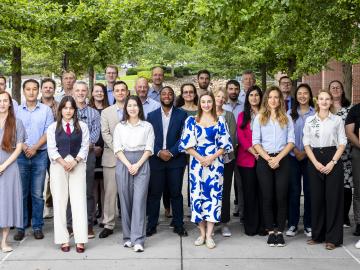
Filter News
Area of Research
News Type
News Topics
- (-) Education (2)
- (-) Environment (105)
- (-) Materials (45)
- 3-D Printing/Advanced Manufacturing (43)
- Advanced Reactors (8)
- Artificial Intelligence (51)
- Big Data (30)
- Bioenergy (51)
- Biology (60)
- Biomedical (31)
- Biotechnology (12)
- Buildings (23)
- Chemical Sciences (27)
- Clean Water (15)
- Climate Change (52)
- Composites (8)
- Computer Science (89)
- Coronavirus (17)
- Critical Materials (5)
- Cybersecurity (14)
- Decarbonization (47)
- Emergency (2)
- Energy Storage (30)
- Exascale Computing (30)
- Fossil Energy (4)
- Frontier (26)
- Fusion (31)
- Grid (26)
- High-Performance Computing (49)
- Hydropower (5)
- Isotopes (31)
- ITER (2)
- Machine Learning (23)
- Materials Science (48)
- Mathematics (7)
- Mercury (7)
- Microelectronics (3)
- Microscopy (20)
- Molten Salt (1)
- Nanotechnology (16)
- National Security (47)
- Net Zero (8)
- Neutron Science (52)
- Nuclear Energy (56)
- Partnerships (21)
- Physics (31)
- Polymers (8)
- Quantum Computing (22)
- Quantum Science (32)
- Renewable Energy (1)
- Security (12)
- Simulation (33)
- Software (1)
- Space Exploration (12)
- Statistics (1)
- Summit (32)
- Sustainable Energy (48)
- Transformational Challenge Reactor (3)
- Transportation (27)
Media Contacts

Distinguished materials scientist Takeshi Egami has spent his career revealing the complex atomic structure of metallic glass and other liquids — sometimes sharing theories with initially resistant minds in the scientific community.

Three flights, five thousand miles and half a dozen clearances and permissions stood between Tetiana Maltseva and the Department of Energy’s Oak Ridge National Laboratory. When she finally arrived at the lab to represent Ukraine at the 2024 Nuclear Energy Management School, her vision was clear.

A study found that beaches with manmade fortifications recover more slowly from hurricanes than natural beaches, losing more sand and vegetation. The researchers used satellite images and light detection and ranging data, or LIDAR, to measure elevation changes and vegetation coverage. Changes in elevation showed how much sand was depleted during the storm and how much sand returned throughout the following year.

At ORNL, a group of scientists used neutron scattering techniques to investigate a relatively new functional material called a Weyl semimetal. These Weyl fermions move very quickly in a material and can carry electrical charge at room temperature. Scientists think that Weyl semimetals, if used in future electronics, could allow electricity to flow more efficiently and enable more energy-efficient computers and other electronic devices.

In the wet, muddy places where America’s rivers and lands meet the sea, scientists from the Department of Energy’s Oak Ridge National Laboratory are unearthing clues to better understand how these vital landscapes are evolving under climate change.

Advanced materials research to enable energy-efficient, cost-competitive and environmentally friendly technologies for the United States and Japan is the goal of a memorandum of understanding, or MOU, between the Department of Energy’s Oak Ridge National Laboratory and Japan’s National Institute of Materials Science.

Researchers at ORNL and the University of Maine have designed and 3D-printed a single-piece, recyclable natural-material floor panel tested to be strong enough to replace construction materials like steel.

Building innovations from ORNL will be on display in Washington, D.C. on the National Mall June 7 to June 9, 2024, during the U.S. Department of Housing and Urban Development’s Innovation Housing Showcase. For the first time, ORNL’s real-time building evaluator was demonstrated outside of a laboratory setting and deployed for building construction.

John Lagergren, a staff scientist in Oak Ridge National Laboratory’s Plant Systems Biology group, is using his expertise in applied math and machine learning to develop neural networks to quickly analyze the vast amounts of data on plant traits amassed at ORNL’s Advanced Plant Phenotyping Laboratory.

A group of high school graduates and community college students visited ORNL to meet staff and find out just what goes on at a DOE national laboratory. The Job Shadow Day was arranged by tnAchieves, a student support organization that works to increase higher educational opportunities for students across Tennessee through scholarships and mentorship.


